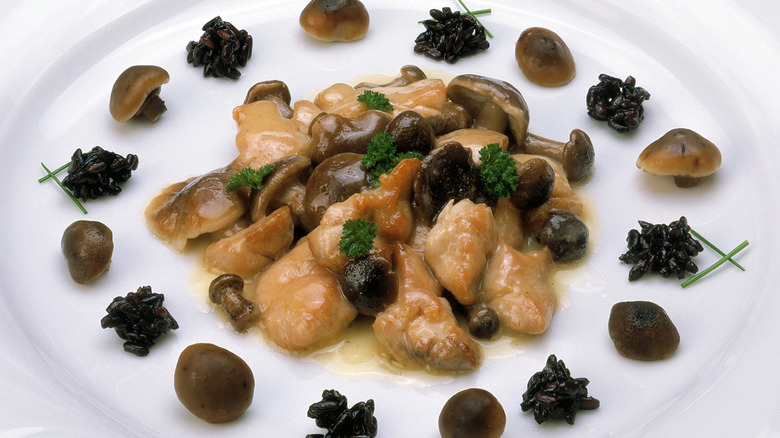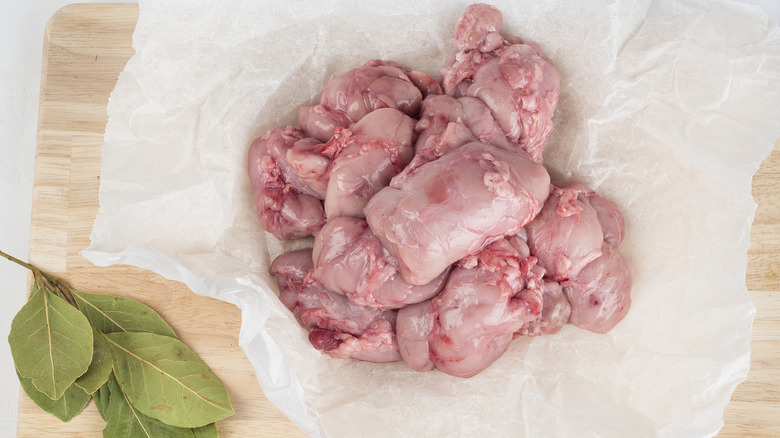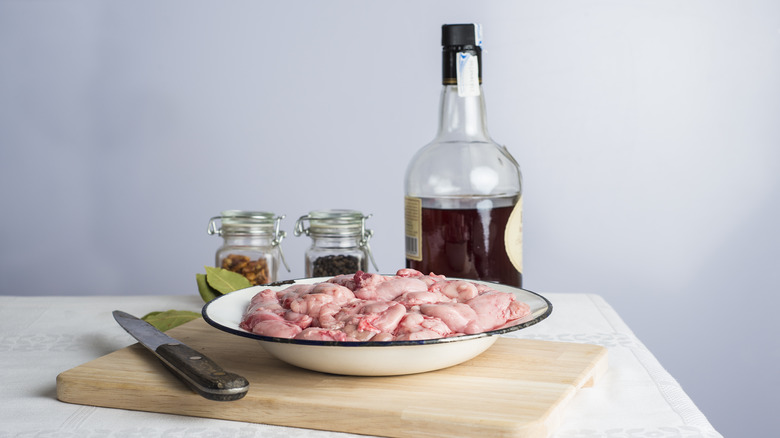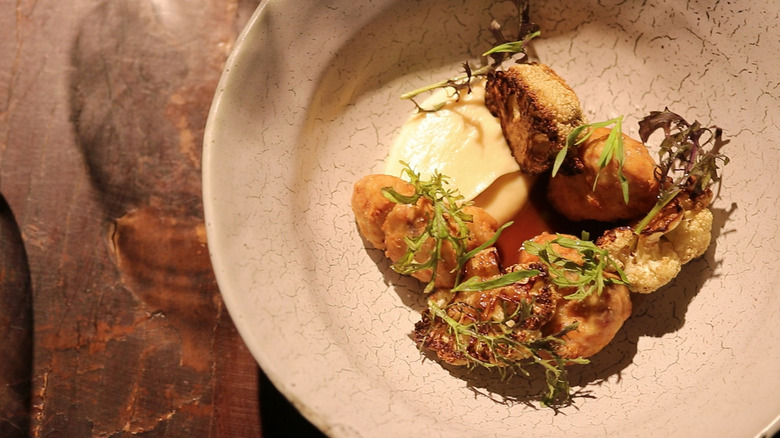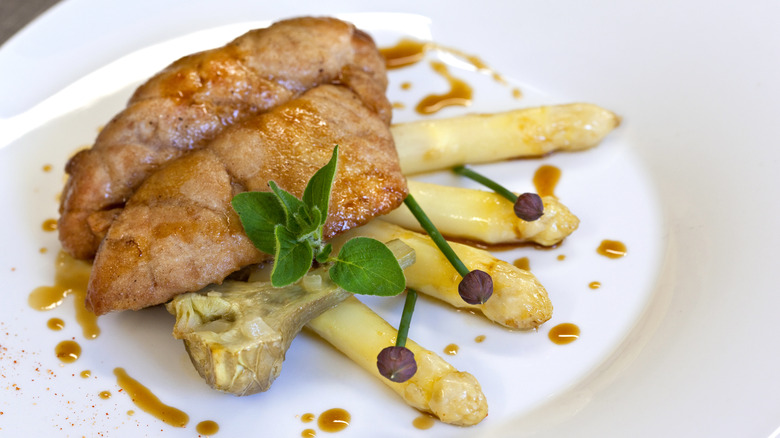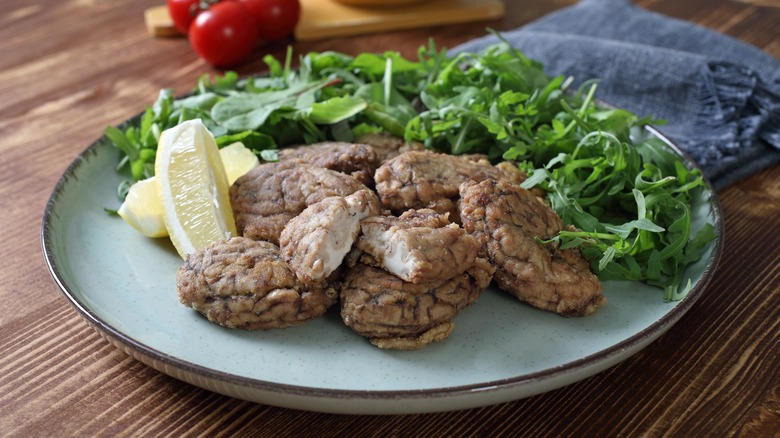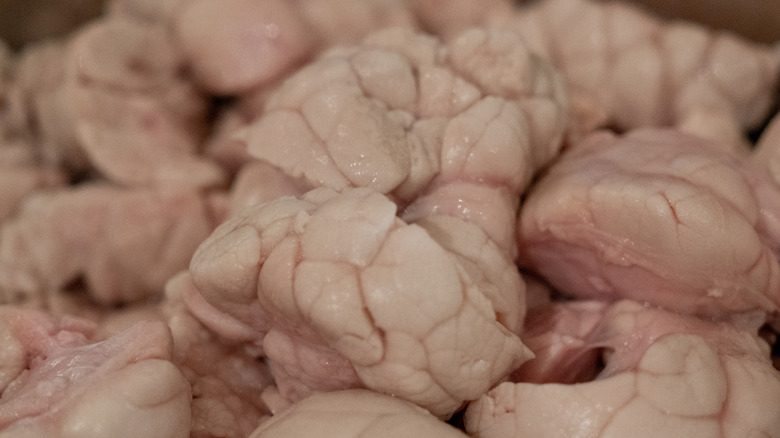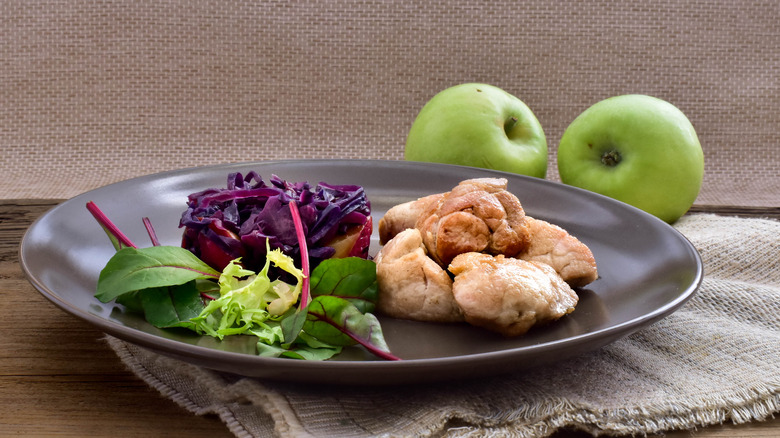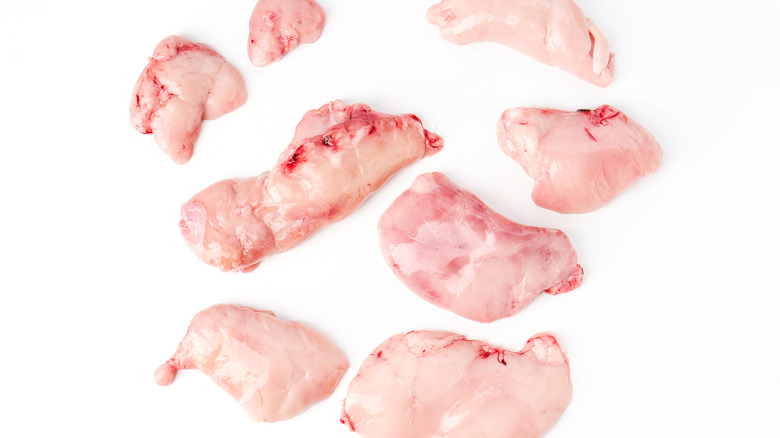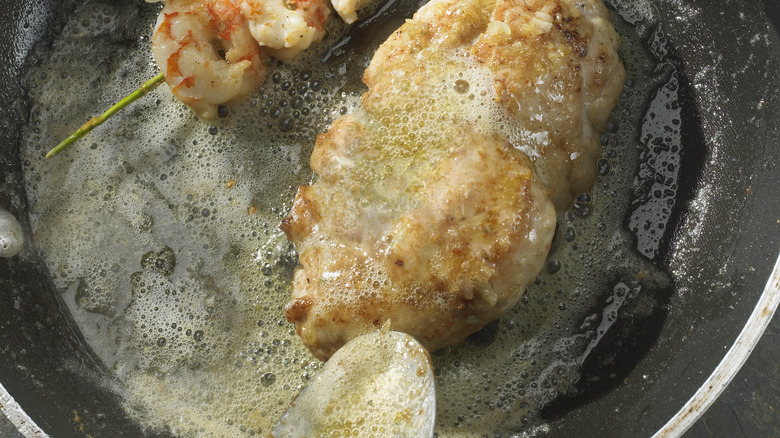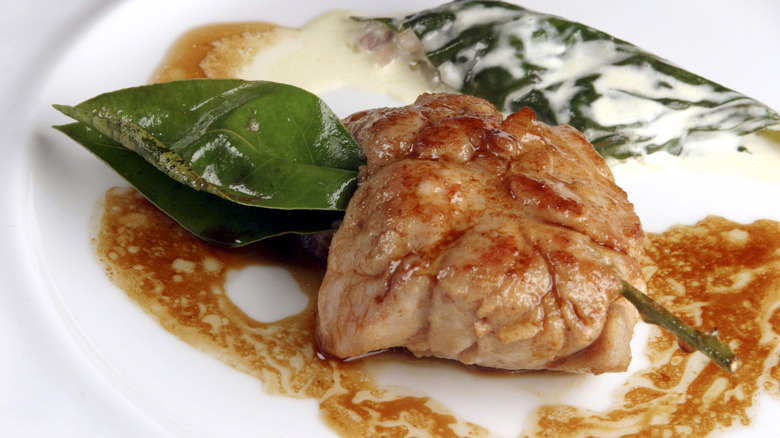A Complete Guide To Sweetbreads
If you clicked on this article looking for information about sugary pastries, prepare to be surprised. Although you may have been misled by the name, that's not what sweetbreads are. In fact, they're pretty much the opposite of that, if opposites exist in food. Rather than being some kind of baked good, they're actually a special cut of meat, specifically a type of offal (confusingly, "sweetmeats" is a historical word for sugary treats like candy and other desserts). Don't let that scare you off, though: Sweetbreads are just as delicious and magical in their own way.
This cut is renowned for its silky texture, unique flavor, and rarity (at least in American stores). For the dedicated home cook, sweetbreads can be a very rewarding project. Even if you never plan on cooking them, they're a great thing to order if you come across them on restaurant menus. Whether you came here looking for cooking tips or are just trying to figure out what sweetbreads taste like, you've come to the right place. This article will tell you everything you need to know about one of the most prized parts of any animal.
What are sweetbreads?
Sweetbreads are a type of meat, but rather than being pieces of muscle, they're actually glands. Usually, things labeled as sweetbreads are either the thymus or pancreas of a (typically young) animal. In the case of the thymus, it has to come from a young animal, usually a calf, but sometimes a lamb (via Culinary Lore).
While Culinary Lore says that the thymus gland's purpose is unclear, according to Cleveland Clinic, at least in humans, the thymus plays a role in the immune system by producing white blood cells. In humans, as in other animals, the thymus shrinks after childhood. The pancreas, which is an organ that produces insulin and other chemicals that are helpful with digestive processes, remains present even in mature animals, notes Frontiers.
Although the term sweetbread now refers exclusively to either the thymus or pancreas, it used to refer broadly to many different kinds of glands that were culinarily useful. Even cow testicles were sometimes called sweetbreads, though now they're often euphemistically labeled as "Rocky Mountain Oysters."
Types of sweetbreads
There is some conflicting information out there about the distinction between the different types of sweetbreads. According to Britannica, the pancreas is the superior variety of sweetbread. Per British Food History, the pancreas is often labeled as the stomach or heart sweetbread, while the thymus is sold as a throat sweetbread.
In contrast, Culinary Lore says that the heart and throat sweetbreads are actually just two parts of the thymus gland. The thymus of a cow is composed of a large, round piece located in the animal's chest that is connected by thin threads to two smaller pieces on each side of the animal's neck. According to this source, the most prized sweetbread is the heart portion of the thymus. It cites Julia Child in support of this assertion. Apparently, the pancreas is often mislabeled as the heart sweetbread, which has led to some confusion. The pancreas is less soft and buttery than the thymus, so for many cooks, the thymus is preferable.
The vast majority of sweetbreads you'll find in butcher shops are veal sweetbreads from young cattle. Lambs have sweetbreads too, but they're a seasonal product that only shows up in springtime.
How are sweetbreads produced?
Since most sweetbreads are veal, the story of how they're produced is the story of how veal is produced generally. Veal is somewhat of a controversial meat. Most veal is a byproduct of the dairy industry. When dairy cows give birth, dairy farmers only want to keep female calves who will eventually produce milk. Since they have no use for the male cattle, the majority of them are slaughtered to make veal (via USDA).
The idea of eating a baby cow upsets some people, and not without reason. According to Sentient Media, there is evidence that separating calves from their mothers at birth is emotionally traumatic for both the calf and the mother. Furthermore, some veal producers in the U.S. still isolate veal calves in individual crates, which can lead to more mental distress. Sentient Media alleges that the feed given to many veal calves is nutritionally deficient, though the USDA says that veal feed delivers all the nutrients the animals need.
As with all meat, the treatment of the animals varies widely depending on the producer. Per Compassion in World Farming, more humane producers raise groups of veal calves together so they can socialize, feed them a more natural diet, and let them suckle from adult cows. If you enjoy sweetbreads but also care about animal welfare, it makes sense to research exactly who is raising the calves your sweetbreads are coming from.
Sweetbreads in history
As with other organ meats or offal like kidneys, liver, and intestines, sweetbreads are something of a niche product these days. You're most likely to encounter them at restaurants, if at all, and if you want to cook them at home, you'll probably have to find a specialty butcher or special-order them.
This was not always the case. In fact, sweetbreads were once so commonplace that they were something of a culinary afterthought, at least in Britain. According to British Food History, at the apex of their popularity in the 1700s and 1800s, fried, breaded sweetbreads were a ubiquitous garnish for meat dishes. These days, they're more expensive and rare than they were back then, so they're treated as a delicacy and usually served on their own.
According to Britannica, sweetbreads historically had a very specific place in multi-course, formal European-style dinners. They were served as their own course, after the appetizer and seafood but before the main meat dish. In this context, they were traditionally served braised, a cooking method that has fallen out of favor and largely been replaced by quicker techniques like pan-roasting or grilling.
What do sweetbreads taste like?
While many people eschew offal because of its strong, barnyard-y flavor, this isn't a problem with sweetbreads. Sweetbreads have a mild, rich taste that's not at all overpowering (via D'Artagnan). Although sources disagree about whether the pancreas or thymus is better, ultimately, they taste fairly similar to each other.
The texture of sweetbreads is more unique and noticeable than their flavor. They have a tender, creamy, unctuous mouthfeel that makes them seem quite luxurious. Cooking methods like searing, roasting, or frying can give them a crispy, browned exterior that contrasts beautifully with the soft interior.
The flavor of sweetbreads changes depending on what type of animal they're from and how old the animal was. The mildest sweetbreads come from young veal, according to Chef's Resources. They're also larger than lamb sweetbreads, which have a more assertive flavor. Sweetbreads from adult cattle (which, given what we know about the thymus, are almost certainly pancreas sweetbreads) are apparently much less tender than the sweetbreads from younger animals.
Sweetbreads vs. brains
Some people might think that sweetbreads are the brains of a calf (via Culinary Lore). While sweetbreads and brains are both considered off-cuts or offal, they're not the same. They're completely different parts of the animal.
That's not to say that brains and sweetbreads are totally dissimilar from a culinary perspective, however. Brains have a soft, creamy texture and a pretty neutral flavor, much like sweetbreads.
The proper technique for preparing brains is also similar to the method for sweetbreads. According to Offally Good Cooking, you have to soak brains to clean them and then peel off their membrane. It's standard to blanch them to firm them up before using them in whatever final recipe you have in mind. This is almost exactly the same as the most common process for prepping sweetbreads (via D'Artagnan). The main difference is that for sweetbreads, you remove the membrane after the blanching step.
Where can you buy sweetbreads?
You're unlikely to find sweetbreads in the meat case at your local supermarket, at least if you live in North America. Chef's Resources says they're more likely to be available from an independent butcher shop. If you happen to live in a city with a Halal meat market, that might be a good place to look as well. It's a good idea to call ahead before visiting the store, as there's a decent chance you'll have to ask the butcher to special-order sweetbreads for you. Veal sweetbreads are the most common, but if you're lucky, you may be able to find rarer lamb or pork sweetbreads.
Look for light-colored sweetbreads that appear juicy and plump. A darker color is a sign that the sweetbreads are from an older animal, which means they will have a stronger flavor and a less desirable texture. It's best to cook sweetbreads as quickly as you can after buying them — they go bad fast. You might be tempted to freeze them to extend their shelf life, but that alters their all-important creamy texture.
If you don't live in a place where you can access sweetbreads, you can have them shipped to you by a retailer like D'Artagnan. However, if you choose this option, you'll be getting a frozen product, and it won't come cheap — D'Artagnan sells two pounds of sweetbreads for around $55.
Sweetbreads nutritional information
According to Live Science, sweetbreads are pound-for-pound the most nutritious piece of a cow. Their reputation for health and nutrition stretches far back into human history. A doctor told the publication that, "Indigenous cultures would serve organ meats to women of childbearing age to boost mom's nutrition."
Sweetbreads have a wide variety of beneficial nutrients in them. They're filled with mono- and polyunsaturated fats that are good for your heart health, regulating cholesterol, and maintaining proper blood sugar levels. They are also rich in vitamins K, A, and E, as well as a variety of other trace minerals. The nutrition facts from Nutritionix show that sweetbreads contain a relatively small amount of fat overall for food that tastes so rich and decadent.
That doesn't mean that you should start eating sweetbreads every day, however. They're high in purines, which can lead you to develop gout. Also, one serving of sweetbread has an entire day's worth of cholesterol in it. While cholesterol consumption isn't actually the biggest contributor to high cholesterol, people with certain chronic illnesses should be particularly careful about their cholesterol intake (via Harvard T.H. Chan School of Public Health).
How to prep sweetbreads
If you've managed to score sweetbreads from a butcher somehow, you're probably excited to cook them and get them in your belly. However, you shouldn't just take them out of the package and fry them or put them on the grill immediately. In order to give them the best possible flavor and texture, it's important to properly prep the sweetbreads before cooking them.
The first step is to soak the sweetbreads for a few hours in cool, salted water. It's best if you use a few changes of water. This rinses away impurities like blood that can give sweetbreads an off flavor. After soaking, you par-cook the sweetbreads in boiling water or stock to make their texture a little firmer. Finally, after poaching, you can trim away the tough gristle and membrane. This is a finicky process, as the sweetbreads will still be quite delicate at this stage (via British Food History).
This is the most basic way to get sweetbreads recipe-ready. Chef's Resources lists some variations you may want to try. You can add something acidic like vinegar or lemon juice to the initial cold water bath, or use milk instead. Rather than blanching or poaching in boiling liquid, you could try cooking the sweetbreads sous-vide at 149 F after they're soaked. There are many ways to reach the same result: clean-tasting sweetbreads that are a little bit firmer than they are when they're raw.
How to cook sweetbreads
Once your sweetbreads are prepped, you can use them in any number of ways. If you're trying to be very traditional, there's an optional fourth prep step: You can use something heavy to press them down for a couple of hours. The pressure gives them a firmer texture, but the primary reason to do this is that it makes the sweetbreads a more uniform shape. If you're not super concerned with the aesthetics of the final dish, this step is unnecessary (via D'Artagnan).
Since sweetbreads have such a soft and creamy texture, it's nice to add something crispy to them for contrast. You can do this by pan-searing them or breading them and tossing them into the deep-fryer. With these methods, you should cook the sweetbreads quickly so they stay soft and juicy in the middle. Alternately, you can reinforce sweetbreads' creamy texture by braising them and serving them with some kind of rich, creamy sauce. If you're feeling particularly ambitious, you can try Thomas Keller's recipe from the French Laundry, which involves pressing, searing, poaching, and roasting the sweetbreads, says French Laundry at Home.
If that all sounds daunting to you, you can try simply grilling your sweetbreads. According to Britannica, this approach is particularly popular in certain regions of South America.
Why are they called sweetbreads?
We've answered most of the questions about sweetbreads you might have, but one mystery remains unanswered: Why are they called sweetbreads in the first place? They're not really sweet, and they're certainly not a type of bread.
Let's start with the "sweet" part of the name first. While sweetbreads may not be sweet in the sugary sense, their mildness means they might be perceived as sweeter than other parts of an animal. In addition, sweet doesn't always mean sugary. Per the Online Etymology Dictionary, the original meaning of sweet in Old English was "pleasant." This may have been what was meant in the first written instance of the word sweetbread in an English book from the 1500s titled "The Historie of Man." This book called the thymus gland the "most pleasant to be eaten... the sweete bread," (via Taste).
So that explains the "sweet," but what about the "bread?" According to Taste, we can look to Old English for the answer to that question as well. The word bread is a form of the Old English term bræd, which meant "meat." If you're fluent in Old English, the name sweetbread makes perfect sense!
